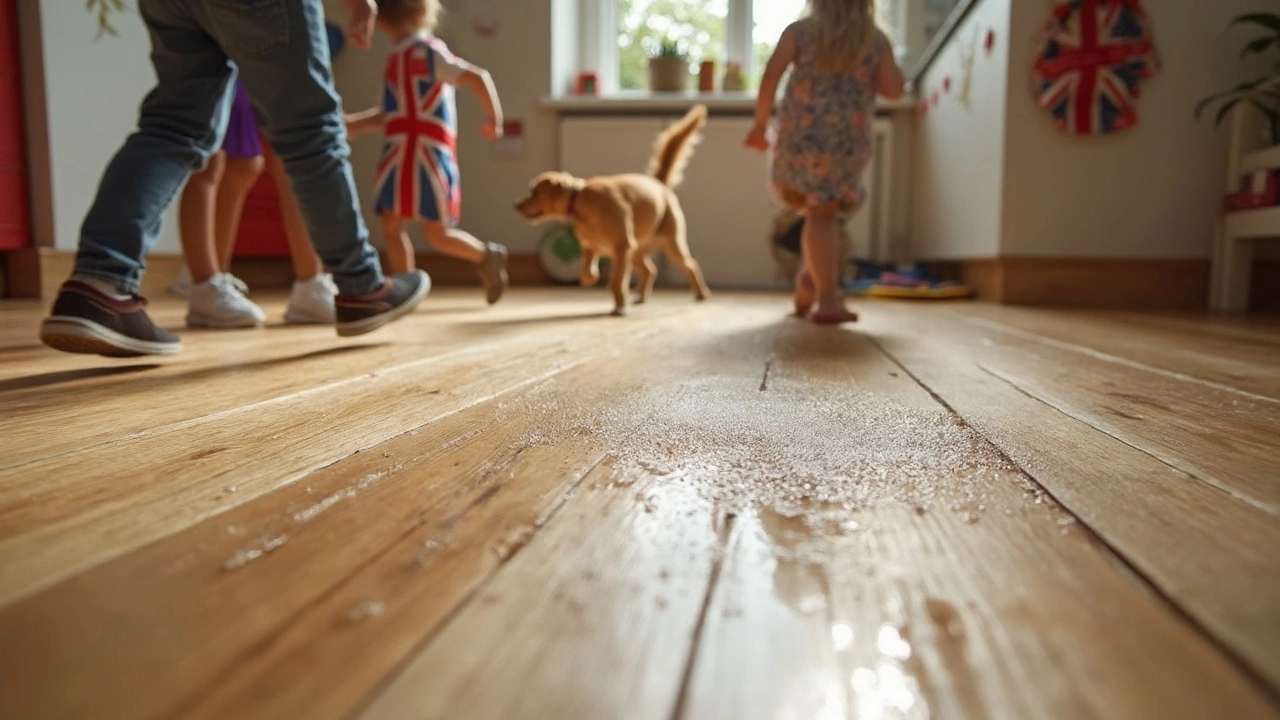Ever wondered why some floors look nearly brand new after decades of heavy traffic, while others start falling apart before the new-home smell is gone? Your floor’s lifespan depends on a mix of what it’s made from, how you treat it, and, yes, sometimes just plain luck. But don’t worry, you don’t need luck when you know what actually holds up against real-life messes.
If you’re planning a big flooring upgrade, it makes sense to focus on what’ll last, not just what looks good on day one. The difference between floors that tap out after a few years and ones that hang around for thirty or more usually comes down to specific materials—and a few smart care habits. Stick around, and I’ll break down which options genuinely go the distance—and what you should keep in mind before you shell out the cash.
- What Makes Flooring Last?
- The Top Contenders: Pros and Cons
- Surprising Flooring Facts You Should Know
- Making Your Floors Last Even Longer
What Makes Flooring Last?
Durability in flooring isn’t just about putting down something hard and hoping for the best. There are definite reasons why some floors keep looking good year after year, while others start showing their age quickly. The big deal-breakers are materials, wear layers, installation, and environmental factors.
First, the material itself matters most. Harder surfaces like porcelain tile and natural stone are naturally built to resist scratches, water, and heavy foot traffic. That’s why you see tile floors in busy airports or hospitals lasting 20 years or even longer. Some luxury vinyl and engineered hardwood brands have actually figured out how to mimic this resilience pretty well by stacking up multiple protective layers.
Another biggie is the wear layer—basically, the top coat that takes all the abuse. Floors with thicker, stronger wear layers (like quality vinyl or laminate) handle dents, pet claws, and spilled juice without breaking a sweat. If a floor’s wear layer is thin or cheap, it doesn’t really matter what’s underneath—it’s going to show damage fast.
How a floor is installed also plays a role. If the subfloor is uneven or there are gaps, that opens the door for cracks, warping, and moisture issues. Even the strongest floors give in when they aren’t supported right from the start.
Finally, there’s just how much life you throw at your floors. Sunlight, humidity, water leaks, and dragging furniture are some of the fastest ways to shorten a floor’s lifespan. Even the long lasting flooring options out there need a little routine care to live up to their reputation.
- Materials like porcelain tile, stone, and high-quality vinyl top durability tests.
- Thick, tough wear layers help floors shrug off daily damage.
- Wrong installation leads to early problems—get it done right.
- Consistent care and minimizing brutal wear help any floor live longer.
The Top Contenders: Pros and Cons
So, which types of flooring actually last the longest? Here’s a straight look at the heavy hitters, what helps them win, and where they have a few weak spots.
- Porcelain Tile: Tile floors, especially porcelain, often outlast the people who install them. Properly installed and grouted, porcelain tile can handle direct sunlight, pet nails, muddy shoes, even kitchen floods. It’s hard, scratch resistant, and doesn’t fade. The downside? Dropping heavy stuff can cause cracks, and grout lines might need an occasional deep clean. Installation can be pricey since you need a pro for best results.
- Natural Stone (like slate and granite): This stuff practically laughs at scratches and stains, as long as it’s sealed every so often. Stone floors have been known to last 100 years (historic buildings aren’t lying!). They are cold underfoot and slippery when wet unless you choose a textured finish. Also, higher upfront and maintenance costs can throw people off.
- Solid Hardwood: Classic, beautiful, and—if you sand and refinish it every decade or so—hardwood can last generations. Typical lifespan ranges from 30-100 years depending on traffic and care. It does scratch more easily than tile or stone, and doesn’t love water. If you’ve got dogs or are prone to spills, keep that in mind.
- LVP (Luxury Vinyl Plank): Here’s one you might not expect. High-quality LVP can take a beating, is water-resistant, and stands up great in active homes. The best part? Clips together with minimal fuss. While older vinyl used to yellow and crack, today’s top brands promise 15-25 years without major signs of wear. But super cheap LVP can dent, and it’s not the best for resale value if you’re thinking long term.
- Concrete: Think industrial lofts and modern basements. Polished concrete floors almost never wear out—you’ll likely move before your floor does. It’s immune to water and tough to scratch. But it’s hard underfoot, which not everyone likes, and can feel cold. Cracks sometimes pop up, but they’re usually harmless and add a little character.
Here’s a quick look at how long these contenders can stick around, with some eye-opening lifespan numbers and maintenance notes tossed in for good measure:
| Flooring Type | Average Lifespan | Care Needs | Biggest Drawback |
|---|---|---|---|
| Porcelain Tile | 50+ years | Sweep, mop, check grout yearly | Cracks if struck hard |
| Natural Stone | 50-100 years | Seal occasionally, sweep | Cold, slippery, pricey |
| Solid Hardwood | 30-100 years | Refinish when worn, sweep often | Water damage, scratches |
| Luxury Vinyl Plank | 15-25 years | Sweep, mop, no wax | Dents, lower resale value |
| Polished Concrete | 50+ years | Seal every few years, sweep | Hard and cold underfoot |
The takeaway? Your choice really comes down to lifestyle, budget, and what kind of stress your floors will see day in and day out. Each tough option comes with its own set of maintenance quirks, but if you’re after the long lasting flooring, it’s hard to beat tile, stone, and concrete for sheer toughness.

Surprising Flooring Facts You Should Know
There’s more to long-lasting flooring than just picking the toughest-looking plank. Some facts might totally throw you:
- Porcelain tile is often called the superhero of floors. It’s fired at super-high temps, making it resist scratches, stains, and even water damage. This is why you’ll see tiled corridors in busy airports and schools—it’s just that hard to kill.
- Engineered hardwood looks fancy but can take more abuse than traditional hardwood because of its layered construction. So if you want wood without the stress about dents, that’s your guy.
- Ever heard of luxury vinyl plank (LVP)? It’s not your grandma’s vinyl. Today’s LVP is nearly waterproof and way more forgiving if you have wild pets or messy kids.
- Some floors can wear out fast just from daily sunlight! Natural wood and basic vinyl will fade or discolor if you don’t use blinds or window film.
If you’re a stats person, check out this durability cheat sheet:
| Flooring Type | Average Lifespan (Years) | Main Weakness |
|---|---|---|
| Porcelain Tile | 50+ | Grout stains, can crack if heavy objects are dropped |
| Solid Hardwood | 30-100 (with refinishing) | Scratches, water damage |
| Luxury Vinyl Plank (LVP) | 15-25 | Can dent, less eco-friendly |
| Laminate | 10-20 | Susceptible to moisture |
| Carpet | 5-15 | Staining, matting, not for high-traffic |
Maintenance plays a huge role, too. Did you know simply using furniture pads and cleaning spills right away can give your long lasting flooring several extra years?
- Tile and LVP can usually handle even big dogs and lots of foot traffic, while carpet needs constant cleaning and is toast in homes with heavy use.
- Refinishing real hardwood every 10-15 years means you can keep it looking new practically forever—way longer than most people stay in one house.
One more thing: Sometimes, “lifetime warranty” really just means “as long as you follow an exact care routine or have zero kids, zero pets, and live alone.” Always check the fine print.
Making Your Floors Last Even Longer
If you want to get the most years out of your floors—no matter what type you choose—you’ve got to be a little proactive. Even long lasting flooring can crack, fade, or warp without the right care. But the good news? It doesn’t take a ton of effort, just a bit of know-how and consistency.
Let’s break down some of the smartest ways to keep your floors looking sharp and functioning well for as long as possible:
- Don’t skip the doormats. One of the easiest tips: put quality doormats at every entrance. This cuts down on dirt and grit, which can scratch up both hardwood and luxury vinyl in no time.
- Stick to gentle cleaning routines. For most floors, skip harsh chemicals. Use a damp mop (not soaking wet) for hardwood and laminate. For tile, neutral cleaners work best. Vacuum regularly (with a soft brush attachment) on carpet.
- Watch the humidity. Wood floors hate big swings in humidity—too much moisture can make them swell, too little makes them shrink and crack. Keep indoor humidity between 35% and 55% if you can.
- Use felt pads under furniture. Those small felt pads stop your couch or chairs from leaving gouges that are tough (or impossible) to fix.
- Deal with spills right away. Especially with wood or laminate, letting moisture sit for too long is a recipe for stains, warping, or mold.
If you’re the type that likes specifics, check out how maintenance affects the average lifespan of common flooring types. You might be surprised how much difference simple upkeep makes!
| Floor Type | Average Lifespan (Low Maintenance) | Average Lifespan (Good Maintenance) |
|---|---|---|
| Solid Hardwood | 15-20 years | 30-100 years |
| LVP (Luxury Vinyl Plank) | 10-15 years | 20-25 years |
| Porcelain Tile | 25-40 years | 50+ years |
| Laminate | 7-10 years | 15-20 years |
| Carpet | 5-7 years | 10-15 years |
Here’s a tip most people miss: refinish, don’t replace, whenever possible. You can sand and refinish hardwood a few times during its life, making it look almost new and easily doubling its time in your home. Even tile grout can be refreshed or re-sealed instead of tearing up the whole floor when it starts to look dingy.
If you stick to these habits and handle issues as soon as they pop up, your floors will run circles around their expected lifespans—and you’ll spend less money over time.


